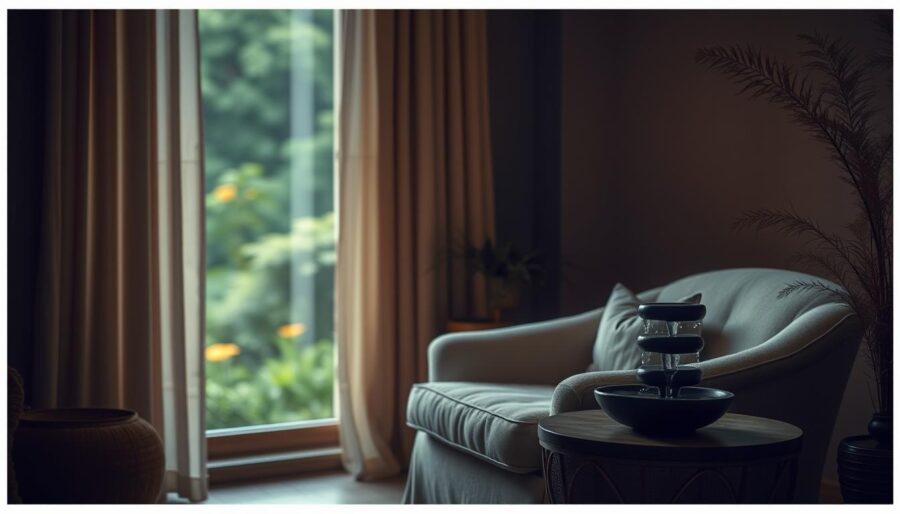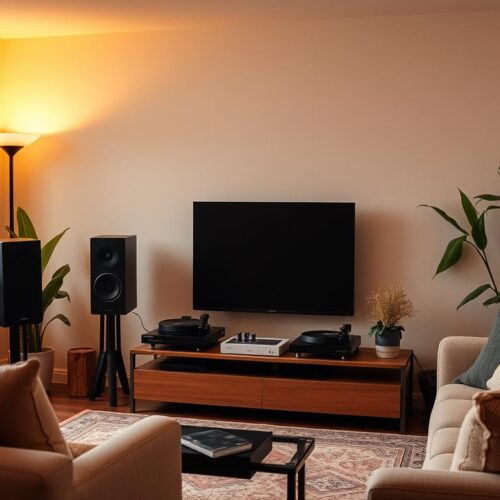You can change your at-home atmosphere with thoughtfully chosen audio that masks distractions and helps your brain settle faster. myNoise creates engineered environments—like Irish Coast and Cafe Restaurant—that minimize nuisances and boost focus without pulling at your attention.
Earth.fm offers a vast library of authentic nature recordings from around the world. You’ll find rain, ocean waves, and gentle wind that create a steady background and increase comfort during work or rest.
Relaxing White Noise adds long-form tracks such as a 10-hour “Peaceful Rain” for sleep and calm. Keep playback at safe volumes and consult a physician for persistent hearing or sleep issues.
In this article, you’ll learn simple ways to use rain, white noise, or ambient cafe hum to shape your daily routine. Expect practical tips to support relaxation, focus, and better sleep across rooms and setups.
Why indoor relaxing sounds work right now: science, benefits, and mood lifts
Predictable audio, like rain, calms the nervous system by reducing sudden contrasts in your environment. Scientists say steady patterns help the brain downshift from alert mode to rest-and-digest states.
Rain often acts as a form of white noise, masking spikes such as traffic or voices. That smoothing effect lowers stress, reduces startle responses, and can improve sleep in noisy settings by as much as 38%.

- You get a calmer experience because steady input creates a reliable auditory pattern.
- Different types or sources—light patter, steady roof rain, or a storm with distant thunder—change intensity and immersion.
- Some listeners note ASMR-like tingles with soft, repetitive textures; those details deepen relaxation when present in tracks.
- Keep volume moderate so normal conversation remains possible; stop if you notice ringing or hearing trouble.
Use gentler tracks for reading, denser mixes for deep work, and low-level pulses before bed to signal your body that sleep is next.
Indoor relaxing sounds: a curated resource hub of soundscapes and sources
Build a compact resource hub so you can pick the right soundscape for work, rest, or privacy. Start with a small library that mixes engineered tools and authentic field recordings.
Use myNoise for adjustable generators and themed scenes like Irish Coast (waves, rain, wind), Speech Blocker, and Neuromodulator for tinnitus masking.
- Earth.fm supplies 1,000+ authentic nature sounds recorded across the world—forest canopies, water edges, and tracks with distant thunder.
- Relaxing White Noise offers long-form tracks (for example, a 10-hour Peaceful Rain) for steady background playback.
- Mix Waterfall or White Rain at bedtime, Cafe Restaurant for creative vibes, and Speech Blocker for privacy during calls.
| Source | Best use | Notable options |
|---|---|---|
| myNoise | Custom masking, focus, tinnitus relief | Irish Coast, White Noise & Co, Neuromodulator |
| Earth.fm | Authentic field recordings | Forest rain, waves, distant thunder |
| Relaxing White Noise | Long-form ambient tracks | 10-hour Peaceful Rain, MP3 downloads |
How to use indoor relaxing sounds for focus, sleep, privacy, and well-being
Design a simple playback plan so audio supports each part of your day. For work, pick a steady background like Rain Noise or a calm cafe hum to boost focus and mask sharp noises.
Before bed, create a wind-down window with softer rain, steady waves, or gentle wind. Keep the background low and steady to reduce night awakenings from hallway or street noises and improve sleep.
For privacy, place a small speaker between a conversation and adjacent doors or a window. Use Speech Blocker or a shaped rain track to cover the voice band while preserving a comfortable atmosphere.

- Routine: Pair a stable bed with demanding tasks to train your brain and preserve focus.
- Well‑being: Use water, wind, or a forest soundscape to lower stress and increase comfort.
- Tinnitus: Try Neuromodulator or Summer Night to find a masking pattern that reduces perception.
| Goal | Best source | Use case |
|---|---|---|
| Focus | Rain Noise / Cafe hum | Stable background for deep work |
| Sleep | Soft waves / long-form rain | Nighttime steady masking to cut awakenings |
| Privacy | Speech Blocker / shaped rain | Cover conversations near doors or windows |
Rotate soundscapes across the week—nature mixes for mornings, white noise or hums midday, and water-based ambiences at night. Always keep volume at conversational levels, keep some distance from speakers, and pause if you notice ringing to protect hearing.
Conclusion
Let a single, reliable atmosphere—like gentle rain or a low hum—anchor your daily rituals.
You now have a clear path: pick a dependable sound bed, build a small library, and use the same cue at the same time to strengthen your connection to calm. Try a forest rain one evening and a minimal hum the next day to keep the routine fresh.
Rely on trusted sources such as myNoise, Earth.fm, and Relaxing White Noise for curated soundscapes and field recordings from around the world. Keep volume moderate to protect hearing and to preserve the peaceful background that supports focus, privacy, and sleep.
Start with one track that fits your current goal and use it consistently. Over time, the right mix of rain, hum, and shaped noise will make your environment more supportive of everyday life.




